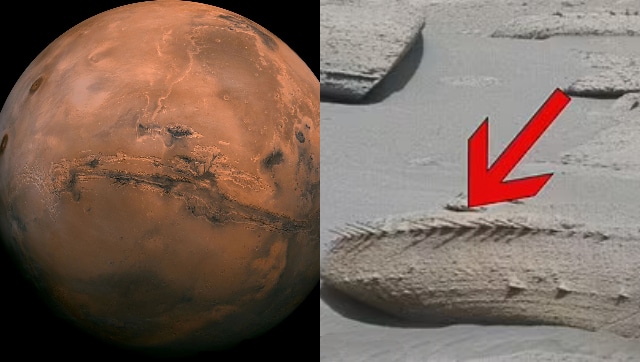
NASA's Curiosity Rover has sent some strange images back to Earth over the years. It may have just sent the strangest images it has ever taken. Curiosity sent over images of a bunch of rocks at the bottom Gale Crater that looks like the remains of a fish or fir tree.
In its most recent set of images uploaded, NASA’s Curiosity rover has shared a number of images of a strange structure on Mars. The images are of a set of structures which are assumed to be that of a rock formation. However, what really sets these structures apart is that they look like the skeletal remains of pre-historic animal.
Images shared by the Curiosity Rover show a bunch of spikes protruding out of a rock-like structure. The images were taken at the base of 154 kilometres long Gale Crater on Mars. The images, which have caused a major debate online were taken on April 1, using Curiosity’s mast camera and ChemCam. Curiosity has been roaming the Gale Crater since August 2012 as part of NASA’s Mars Science Laboratory (MSL) mission.
Some people who have seen the images believe it to be the remains of a fish, while others believe it looks more like the branch of a fir tree. One thing’s for sure though – both camps believe that it is implausible that a natural rock gets formed in that shape, even on Earth. So something of this sort developing on Mars is pretty impossible.

The location where the “bone” like rocks were found is also interesting. It is now a widely accepted fact that Mars, at one point had large waterbodies on its surfaces, and may possibly have some water beneath its surface today as well. The Gale Crater, where the bones were found used to be one of the largest lakes on Mars, before it dried up, somewhere between 3.5 and 3.8 billion years ago. The crater that remains where the lake once stood, is about 154 kilometres wide today.
The rover’s mission objectives include studying the Martian environment and geology as well as preparing for human exploration. It is also continuously sending back photographs of weird things it encounters, such as this spiky rock formation.
Nathalie A. Cabrol, an astronomer, posted a snapshot of it on Twitter, saying, “In 20 years of studying Mars, that’s the most bizarre rock I’ve ever seen.”
There are others who believe that most of the people who see bones of fir bark in those rocks are reading into things that simply aren’t there.
‘Really unusual, never seen anything like this and I have been looking at Mars photographs since the Sojourner mission back in 1997,’ another person said.
Some speculate that Martian winds eroded the rocks over a long period of time.
‘If it blows over loose sand for a sufficiently long number of aeons, any geometric form known to mankind may ultimately be produced,’ wrote Twitter user Martin Weil. Ms, Cabrol also stated that it was most likely the “remains of ripples after lots of erosion.”
One Twitter user wrote, “it looks like a very easy-to-crumble fish vertebra, ‘fish fossils, a mackerel fillet, or skeleton of some prehistoric creature.” While another one wrote, “I’m happy to believe that’s the back of a fossilised Martian dragon, curled up in its final resting place.”
This isn’t the first time the Curiosity Rover has beamed up images that has baffled people on planet Earth. In June last year, the rover discovered several bizarre, twisting structures jutting out of Mars’ surface, which are now assumed to be naturally occurring columns called hoodoos.

According to experts, the columns were most likely formed from cement-like material that formerly filled old fissures in Martian bedrock. The softer rock, however, wore away over time, leaving just the twisted towers of compact material emerging from the sand in the crater.
The rover acquired a snapshot of what seemed to be a coral-like ‘flower’ in the Gale Crater in February 2022, but was actually a minute mineral deposit.
Read all the Latest News, Trending News, Cricket News, Bollywood News,
India News and Entertainment News here. Follow us on Facebook, Twitter and Instagram.


